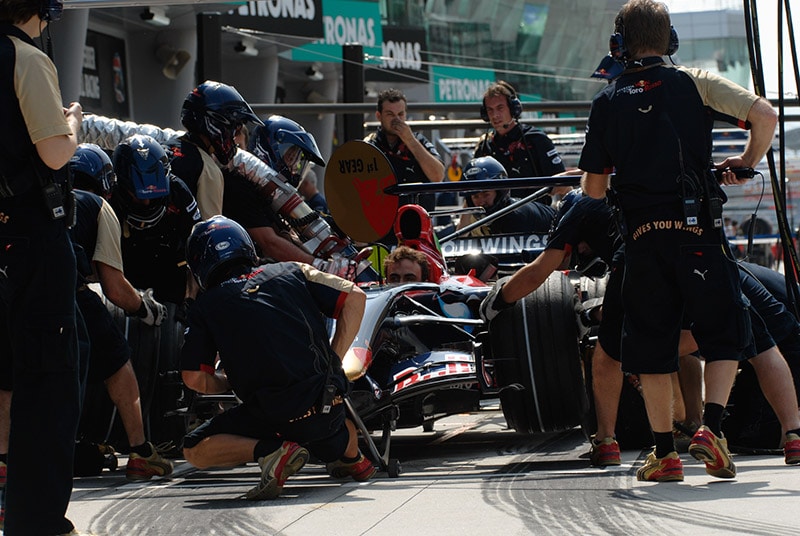While it is common to see athletes gets weighed for things like boxing, you have to admit that it seems kind of weird that a Formula One driver has to weigh in.
Have you ever wondered why F1 drivers weigh in?
Formula 1 drivers get weighed before a race to make sure that they at least meet the minimum total weight racing requirements, and they get weighed after a race to determine how much weight they lost while racing.
So, if you’ve ever wondered why F1 drivers get weighed before a race or why F1 drivers weigh in after a race, there is the quick answer for you.
But if you’d like a few more details on this seemingly odd race requirement, then keep reading.
Below we’ll give you everything you ever wanted to know about weights in Formula 1.
Reasons F1 Drivers Weigh In

As stated above, there is more than one reason that F1 driver have to get weighed – and it happens both before a race and after a race.
To Prevent Cheating
Possibly the most important reason that the drivers get weighed at the start of a race is to make sure that they’re not trying to cheat and come in under the total minimum car + driver weight requirement.
Regulations state that the minimum limit is 795 kg starting with the 2022 season.
That weight limit is for both the driver and dry weight of the Formula 1 car.
Dry weight means the weight of the car before any fluids are added to it.
What you may find interesting is that while the driver’s weight is included in that 795 kg minimum total weight, the driver has his own weight requirements to meet as part of that 795 kg.
The driver must weigh a minimum of 80 kg, or 175 pounds, otherwise a ballast gets added to their F1 car to make up the difference.
What does this mean for the weight of the Formula 1 car?

It means that the minimum weight for the F1 car (remember, dry weight), is 715 kg.
As you might expect, having the least amount of weight possible gives you an advantage in a Formula 1 race, which is why these minimum requirements were introduced.
To Keep The Drivers Healthy
Though you might not realize it watching the race at home, the drivers of these cars get really sweaty during the race, despite the cockpit being open.
And all that sweat results in weight loss for the driver, of course it’s mostly water weight they’re shedding but it can still be dangerous.
By weighing the drivers after the race, they can compare it with the before race weight to determine how much weight was lost by the driver on the speedway.
Typically, a Formula 1 drivers loses between 2 kg and 4 kg of weight during a race.
And since the cockpit of a Formula 1 car reaches 44 degrees Celsius, or 112 degrees Fahrenheit, it’s no surprise that drivers sweat off a few pounds.
The on-site medical teams need to make sure that the drivers don’t experience severe hydration once the race is over, which is also why the drivers weigh in after the race.
The Average Weight Of A Formula 1 Driver
While the drivers are required to weigh a minimum of 80 kg, otherwise a ballast gets added to their F1 car to make up the difference, they do tend to weigh in under that 80 kg.
Most Formula 1 drivers are very lean and tall, with 2021 seeing Esteban Ocon measure in at 6’1″ in height.
For the 2021 season, the average weight of a F1 driver was just 65 kg.
Driver Yuki Tsunoda weighed the least amount in 2021, at just 54 kg, and Antonio Giovinazzi weighed the most of any driver in 2021 at 75 kg.

Minimum F1 Driver Weight Requirement
Up until 2019, there was no minimum weight requirement for drivers, which gave the taller drivers a bit of a disadvantage.
It actually resulted in a lot of them being really unhealthy because they were trying to keep weight down.
Then, in 2019 the minimum driver weight requirement was added to official regulations.
Since 2019, all F1 drivers must weigh a minimum of 80 kg, or 175 pounds, otherwise a ballast gets added to their F1 car to make up the difference.

Final Word
Keep in mind that there is not a maximum weight limit for cars or drivers, just a minimum weight limit of 795 kg in 2022.
Of course, exceeding that minimum requirement just means hurting the performance of the car to a certain degree.
So, it is in the best interest of each team to be as close to that minimum weight limit as possible because less weight means faster speeds.
